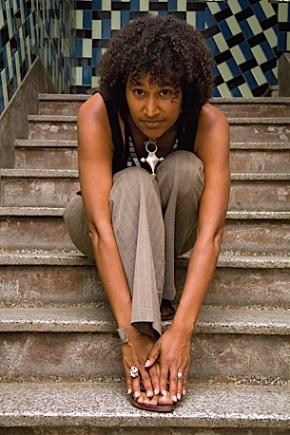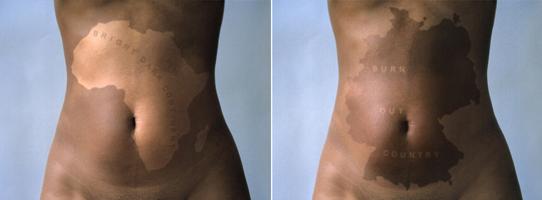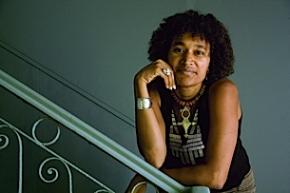Body and Soul - Ingrid Mwangi
A woman’s body, black and thin, portentous, lying down on the floor twitching in movements that denounces suffering. Projected on a screen is the hidden face of a woman, who covers herself with her hands and braided hair.
The body and face used in these performances belong to Ingrid Mwangi, Kenyan artist, who through painting, photography, installation, video, sound and live performances, pursuits sharing a different vision of the world. A challenging and striking piece of work, very innovative and sometimes shocking.
 Ingrid Mwangi, photo by Pedro Dicodemos
Ingrid Mwangi, photo by Pedro Dicodemos
The artist was in Angola for the inauguration of the Goethe Institut in Luanda where she performed an installation called “Es Gangeni”. In zulu this name means “place in the dark” in a mystic sense, having also a dual meaning of something dirty, not acceptable. Coming from Johannesburg where she was touring and on her way to Germany, where she currently lives, we interviewed Ingrid Mwangi. “I react, interpret and question the clichés and stereotypes with which I was, and still am, faced with”, she says.
audience with attitude
The artist’s work has been shown in Luanda through the Sindika Dokolo Foundation, and Ingrid Mwangi presented herself in the National Theater with a great success. “ I believe that the Angolan audience reaction to my performance was lively and visceral. I’m very conscious that my work is weird, almost nonsensical and I know it can provoke reactions varying surprise and shock”, she says.
The audience’s reception to Ingrid’s art is never the same. “When I am in the presence of an audience that its not so saturated by preconceived notions of what art should or should not be, the reaction always ends up being more spontaneous and natural”. In Ingrid’s opinion the public in Angola “was very open hearted” about her work. It’s a matter of commitment established between the audience and the artists. She believes this reception of her work is related to the history of Angolans. Relatively to the western society Angolan’s culture instills them with a less prejudiced attitude.
On her first time in Luanda, during a five-day journey, Ingrid says “for me Luanda, like every city, is defined mainly by its people. I think that they are very open, friendly, available, with a laid back attitude that thrills me”.
The video performer artist uses various means to express her message from experimental voice techniques to the use of text, photography, video and choreography.
Mixed up society
Born in Nairobi, Kenya, Ingrid Mwangi tells about herself she was born in a “mixed-up society. My generation had some disappointments with the politicians and with the deterioration of hope into fear”. At the age of 16, in the midst of adolescent troubles, she went to Germany. “Being African in German society was a huge issue”. Ingrid Mwangi, Static Drift, 2001. Two chromogenic prints
Ingrid Mwangi, Static Drift, 2001. Two chromogenic prints
Ingrid remembers at that time she unwittingly “turned the camera on myself and then looked at myself from the outside, as others do”. Close to adulthood she creates a self-conscience image of her body and the way she was understood by the external world. “All this influenced and molded my work”. But it was not an easy process. “ I was very confused trying to negotiate my way between two different cultures and fulfill my role in them”.
A professor from the Art and New Media School suggested that drawing on her African heritage could provide Ingrid with a head start. Initially she decides against that approach because as she says “at that time it was not something I wanted to influence my art. I already had to deal with being African and black every single day of my life since the moment I wake up. And I was in a German society which was not, and possibly is not yet, a truly multicultural and integrated society”.
Despite her initially conviction she eventually overcame those worries and slowly understood how valuable that duality between two societies could be for her artistic work. Ingrid ended up influenced by the contradictions of belonging to two different worlds, evoking to her work the living experiences of a society in collision. Subjects like discrimination – by skin color, social position or gender- all found an important place in Ingrid’s work. Gradually she has been focusing on conflict issues and the reasons why we live in violence.
In addition to her interest in subjects like the war and the media she is also very interested in the role of women, their strength and their projection in the world. Regarding that she stats “we can’t run away from our body. At the beginning it was not an easy thing to do but I acquired consciousness that my black woman’s body is, by itself, a statement. Then I started to work on this matter”.
the alter-ego
In Germany she meets Robert Hutter who besides being her husband and father of their four children, Ingrid describes as being “my alter ego, my other half. Together we create another personality”. Therefore both have changed their artist’s names and now sign their work with Ingrid Mwangi Robert Hutter, the fusion of their artistic identity.
Ingrid explains “Our work is an assimilation of the impulses which are part of our lives using everything that thrills and hurts us. After that I create an aesthetic way of presenting the work to others. And then we observe how the audience relates and interacts with what is being shown”. Both Ingrid and Robert have a shared vision of art and life. To put in Ingrid’s words “without the other person I wouldn’t exist like this. This is a unequivocal declaration of our connection and the way dependence enters in to our lives”. On one hand, a feminist and African woman. On the other side a European, German man. Ingrid stats “I make an effort to think about me as Ingrid Robert. Since part of what I am and what I do evolves my partner, my children, my mother, every person whom I depend on. Instead of self indulgence this is rather an exercise of inclusion”.
Inspiring family
Ingrid tries to explain to us how intense their work is. Surprisingly, the most simply answer pops up in her mobile phone screen. A photo with four children enjoying the sun. Two boys, five and nine years old, and two fourteen twin girls. The mixed race four kids of Ingrid and Robert are the demonstration of the symbiosis of what they are looking for. “Every year I go to Kenya. I want my children to be in touch with their roots”. Ingrid’s father, a politician and business man, died before knowing the artistic work of his daughter would be appreciated all over the world.
 Ingrid Mwangi, photo by Pedro Dicodemos
Ingrid Mwangi, photo by Pedro Dicodemos
Despite that at first Ingrid’s wish to embrace an artistic career was not approved by her family, she remembers the moment when they recognized her talent. “I remember showing a piece of my work to my father when I was still studying. I explained the concepts to him and he replied that what I was trying to do was very political. In a certain way, I think he understood that I belonged to a generation that doesn’t need to enter in to politics to change things, like he did. He understood I was experimenting with a different way to reach people and participate on a changing society by create awareness of the issues that I cover in my work. Changing things through the art”. Thought he never really understood the fullness of Ingrid’s work, her father did understand her motivation and that her most important goal was “to provide others with a moment of awakening through my art”.
For the power of art in times of distrust
Ingrid Mwangi believes” art must play several roles, fit diverse goals and, at the same time, doesn’t need to pursue a specific objective. To me that’s the power of art”. The artist sustains that art provides to society a different vision of the world alternative to science and religion.
According to her concept, artists are individuals who release themselves and free their minds in a certain way, trying to connect the things they see to create a space where something new emerges. She explains “I don’t have a concrete political agenda but my work, because it is performed with our two bodies, mine and Robert’s, becomes social and human”. For Ingrid, her way in art followed her life’s natural process. “When we came to the world we came full of naiveté, willing to trust in others. We didn’t have another choice. That continues through our childhood. We are very religious in that sense: we accept what we have. At a certain point in our life, during our teenage years, we go out of that cocoon and get to know other environments, other people and that makes us question some things”.
“We don’t want to show only our problems. I don’t want to be stuck on fear. I want to do something positive. We need to be more ethical, and be more responsible towards the environment, for example”. With her often disturbing performances, the artist fights against skepticism. “Some people are skeptical, don’t believe in the authenticity. They doubt. Don’t trust. We live in a era of distrust that we have to eliminate”.
Ingrid is going to participate in the second edition of Luanda’s Trienal, taking place between September and December 2010. She at the moment is researching non-violence movements and their political and ideological background.
Article published in magazine “VIDA”, newspaper “O PAÍS” (Angola, 2009)